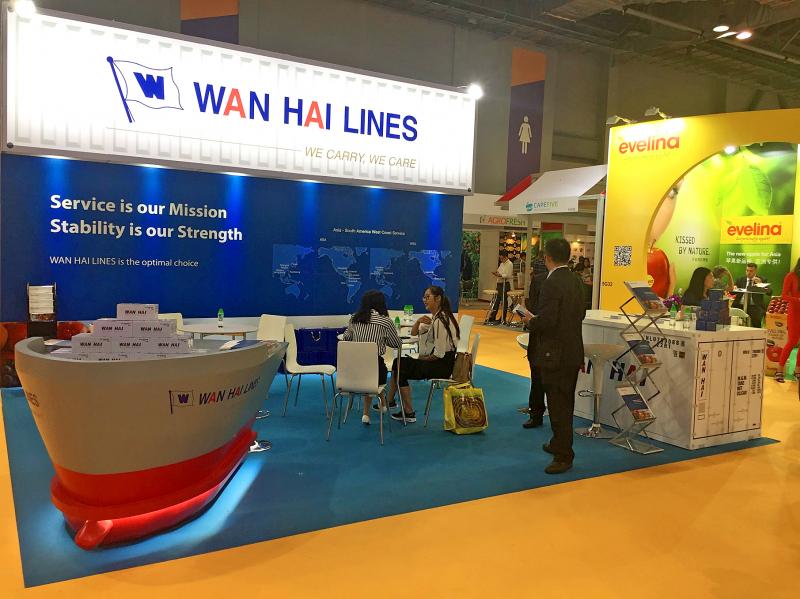Wan Hai Lines Ltd (萬海航運) has purchased 50,000 twenty-foot equivalent unit containers from China International Marine Containers Ltd (CIMC, 中國國際海運集裝箱) at a cost of US$141.73 million amid a global container shortage, the company said in a filing with the Taiwan Stock Exchange on Monday.
The average price of the containers would be US$2,835 per unit, Wan Hai said.
The company expects to receive the containers from the second quarter onward, Wan Hai spokeswoman Laura Su (蘇麗梅) told the Taipei Times by telephone yesterday.

Photo courtesy of Wan Hai Lines Ltd
Most of the new containers would be 40-foot high-cube containers, one of the most commonly used containers for ocean freight, Su said.
“It is difficult to predict when the container shortage would end, although some people expect the shortage to end after the Lunar New Year holiday,” Su said. “We hope to resolve the issue as early as possible with the purchase of new containers.”
The shortage was caused by many containers piling up at ports or being “in the wrong places,” due to congested seaports and reduced personnel amid COVID-19 lockdowns worldwide, Su said.
Therefore, containers have been taking longer returning to their places of origin, which disrupted the logistics chain and caused concerns for Wan Hai’s customers, she said.
The purchase is not a particularly big order for Wan Hai, as the shipper buys new containers with a similar combined capacity every year, Su said.
However, it came earlier than expected, as Wan Hai had bought 37,000 containers in October last year from CIMC for US$109 million, she said, adding that the company has begun taking delivery of some of those containers.
The average age of Wan Hai’s containers is 4.3 years, lower than the global average of 6.6, she said.
The shortage has driven up sea freight rates, which boosted Wan Hai’s revenue last quarter to a record NT$11.6 billion (US$408.31 million), up 75 percent year-on-year.
Wan Hai has a rosy outlook for its orders leading to the Lunar New Year holiday, but the post-holiday outlook remains unclear, Su said.
Wan Hai owned 66 ships and was chartering 39 ships as of Sept. 1 last year.
Intra-Asian routes contributed 70 percent to its total revenue, followed by Middle Eastern and Indian routes with 20.6 percent. The US and South American routes accounted for 5.6 percent and 6.6 percent respectively, company data showed.

Mercuries Life Insurance Co (三商美邦人壽) shares surged to a seven-month high this week after local media reported that E.Sun Financial Holding Co (玉山金控) had outbid CTBC Financial Holding Co (中信金控) in the financially strained insurer’s ongoing sale process. Shares of the mid-sized life insurer climbed 5.8 percent this week to NT$6.72, extending a nearly 18 percent rally over the past month, as investors bet on the likelihood of an impending takeover. The final round of bidding closed on Thursday, marking a critical step in the 32-year-old insurer’s search for a buyer after years of struggling to meet capital adequacy requirements. Local media reports

TECHNOLOGICAL RIVALRY: The artificial intelligence chip competition among multiple players would likely intensify over the next two years, a Quanta official said Quanta Computer Inc (廣達), which makes servers and laptops on a contract basis, yesterday said its shipments of artificial intelligence (AI) servers powered by Nvidia Corp’s GB300 chips have increased steadily since last month, should surpass those of the GB200 models this quarter. The production of GB300 servers has gone much more smoothly than that of the GB200, with shipments projected to increase sharply next month, Quanta executive vice president Mike Yang (楊麒令) said on the sidelines of a technology forum in Taipei. While orders for GB200 servers gradually decrease, the production transition between the two server models has been

US sports leagues rushed to get in on the multi-billion US dollar bonanza of legalized betting, but the arrest of an National Basketball Association (NBA) coach and player in two sprawling US federal investigations show the potential cost of partnering with the gambling industry. Portland Trail Blazers coach Chauncey Billups, a former Detroit Pistons star and an NBA Hall of Famer, was arrested for his alleged role in rigged illegal poker games that prosecutors say were tied to Mafia crime families. Miami Heat guard Terry Rozier was charged with manipulating his play for the benefit of bettors and former NBA player and

BETTER THAN EXPECTED: The firm’s Q3 results exceeded its projections, based on ‘the underlying strength of our core markets,’ chief financial officer Dave Zinsner said Intel Corp returned to profitability and gave an upbeat revenue forecast after PC demand grew, suggesting that it is making progress on a long and challenging comeback attempt. In the third quarter, revenue rose 3 percent to US$13.7 billion. The Santa Clara, California-based company posted its first quarterly net income since the end of 2023, with earnings per share of US$0.23, excluding some items. Analysts had estimated sales of US$13.2 billion and earnings per share of US$0.01 on average, according to data compiled by Bloomberg. Fourth-quarter sales would be roughly US$13.3 billion, the company said in a statement on Thursday. Intel shares gained about